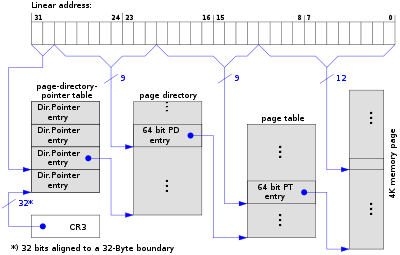- Physical Address Extension
-
Physical Address Extension (PAE, engl. für Erweiterung (der) physischen Adressierung) ist eine technische Erweiterung aus dem Gebiet der Rechnerarchitektur. Sie ermöglicht es x86-kompatiblen CPUs, im 32-Bit-Modus mehr physischen Arbeitsspeicher anzusprechen als durch die 32-Bit-Wortbreite des Mikroprozessors festgelegt. Mit PAE ist der gesamte vom Prozessor adressierbare Hauptspeicher nutzbar.
PAE wird bei Prozessoren (ab Intel Pentium Pro, AMD Athlon) eingesetzt, um mehr als 4 GiB Arbeitsspeicher benutzen zu können. Dies ist möglich, da diese Prozessoren einen breiteren Adressbus besitzen (36 Bit beim Intel Pentium Pro bis Intel Core 2; 40 Bit bei AMD Athlon 64). Spezielle Erweiterungen in der Paging-Einheit der CPU sorgen dafür, dass größere physische Adressen generiert werden.
-
Prozessor Adressleitungen adressierbarer Speicher I386 bis Intel Pentium 32 4 GiB (kein PAE) Intel Pentium Pro bis Intel Core 2 36 64 GiB Intel Xeon 38 256 GiB AMD Athlon 64 (K8) 40 1024 GiB = 1 TiB AMD K10 Architektur 48 262.144 GiB = 256 TiB theoretisches Limit von PAE 52 4.194.304 GiB = 4096 TiB
Der in einem Prozess bzw. einem Task nutzbare Speicher ist jedoch weiterhin auf 4 GiB begrenzt, sofern man ein lineares Speichermodell („flat memory“) verwendet, da die verwendeten Adressregister nur 32 Bit breit sind.
Um PAE nutzen zu können, muss es vom Betriebssystem unterstützt werden. Dabei ist es nicht in allen Fällen sinnvoll, die entsprechenden Optionen zu aktivieren. PAE erfordert höhere Kosten bei der virtuellen Speicherverwaltung und dem Paging, sowie für 32-Bit PCI-Zugriffe. Sind weniger als 4 GiB Hauptspeicher vorhanden, kann es daher vorteilhaft sein, auf PAE zu verzichten.
Auf den meisten Rechnern ist PAE trotz der Hauptspeicherbegrenzung aktiviert. Der Grund dafür liegt darin, dass nur mit PAE auch das auf vielen Prozessoren vorhandene NX-Bit genutzt werden kann.
Inhaltsverzeichnis
Unterstützung der Betriebssysteme
BSD-Familie
FreeBSD unterstützt PAE in der 4.x Serie ab 4.9, in der 5.x Serie ab 5.1 und in allen 6.x Versionen und allen späteren Versionen. Die PAE-Konfigurationsoption wird im Kernel benötigt. Ladbare Kernelmodule können nur in einen Kernel mit aktiviertem PAE geladen werden, wenn die Module mit aktiviertem PAE erstellt worden sind. Nicht alle Treiber unterstützen mehr als 4 GB Arbeitsspeicher. Diese Treiber würden unter einem System mit aktiviertem PAE nicht richtig laufen. NetBSD sowie OpenBSD (bisher nur in -current) unterstützen PAE ebenfalls. Alle adressieren den gesamten 64-GiB-Adressraum.
Haiku
Physical Address Extension wird seit der Haiku R1 Alpha 3 Version des OpenSource Betriebssystems Haiku unterstützt.[1]
Linux
Der Linux-Kernel beinhaltet die volle PAE-Unterstützung ab der Version 2.3.23. Um PAE zu aktivieren, muss die CPU auch PAE unterstützen und der aktive Kernel mit der Unterstützung für PAE konfiguriert und kompiliert worden sein. Je nach Konfiguration unterstützt 32-Bit Linux so 896 MiB (ohne CONFIG_HIGHMEM), bis zu 4 GiB (mit CONFIG_HIGHMEM4G) oder bis zu 64 GiB Arbeitsspeicher (mit CONFIG_HIGHMEM64G, welches PAE aktiviert),[2] wobei „bis zu“ bedeutet, dass dies von der Hardware (wie z. B. dem PCI-Adressraum) abhängt. Seit 2009 starten viele Linux-Distributionen standardmäßig mit PAE-aktiviertem Kernel, da PAE für das NX-Bit benötigt wird. 64-Bit Linux unterstützt 44 physische Speicherbits und somit 16 TiB RAM.[3]
Mac OS X
Mac OS X für Intel Macs unterstützt PAE und das NX-Bit auf allen CPUs, die von Apple unterstützt werden (ab 10.4.4). Mac Pro werden aktuell mit bis zu 64 GiB RAM ausgeliefert.
Microsoft Windows
PAE wird von folgenden Versionen von Microsoft Windows unterstützt und muss hierbei zumeist durch eine Bootoption aktiviert werden:
Windows Versionen (und das Maximum an Arbeitsspeicher) 32-bit Editionen (in GiB) 64-bit Editionen (in GiB) Windows 2000 Professional, Server 4 N/A Windows 2000 Advanced Server 8 N/A Windows 2000 Datacenter 32 N/A Windows XP Starter 0.5 N/A Windows XP Home & Media Center 4 Windows XP Professional 4 32 Windows Server 2003 Web 2 N/A Windows Server 2003 Small Business, Home, Storage 4 N/A Windows Server 2003 Enterprise Storage 8 N/A Windows Server 2003 Standard (SP1/SP2/R2) 4 32 Windows Server 2003 Enterprise (SP2) 64 2048 Windows Server 2003 Datacenter (SP2) 128 2048 Windows Vista Starter 1 N/A Windows Vista Home Basic 4 8 Windows Vista Home Premium 4 16 Windows Vista Business, Enterprise, Ultimate 4 128 Windows Server 2008 Standard, Web 4 32 Windows Server 2008 Enterprise, Datacenter 64 2048 Windows 7 Starter 2 2 Windows 7 Home Basic 4 8 Windows 7 Home Premium 4 16 Windows 7 Professional, Enterprise, Ultimate 4 192 Für die Address Windowing Extension müssen je nach Windows-Version eventuell zusätzliche Service Packs eingespielt werden.
Solaris
Solaris unterstützt PAE ab Version 7.
Siehe auch
Einzelnachweise
-
Wikimedia Foundation.

